In an age where everyday investors are increasingly empowered by technology and information, the stock market has witnessed a unique dichotomy in behavior patterns. During a week of monumental instability prompted by President Donald Trump’s erratic tariff strategies, retail investors like Rachel Hazit saw opportunity while large institutional investors reacted with panic. Despite a significant downturn, Hazit and many others choose to pour cash into equities, operating under the seasoned adage of “buying the dip.” This wave of optimism is noteworthy as it reflects a fundamental shift in the mentality surrounding market participation.
The response from professional strategists was considerably more reserved, if not outright fearful. Institutional investors are often end-users of deep analysis and broader outlooks, which led them to reduce their forecasts significantly when confronted with Trump’s proposed tax policies on imports. Their abandonment of certain equities reflects a clear sentiment of bearish caution. In stark contrast, Hazit’s approach signifies a refreshing level of independence from Wall Street’s traditional fears, suggesting that a new breed of investors is emerging—those unshackled from the reigns of conventional wisdom.
The Logic Behind “Buying the Dip”
The resounding confidence from retail traders can be linked to an unwavering belief in the efficacy of the “buy the dip” strategy. Historically, this approach has yielded favorable outcomes, particularly for those who have held positions over the long term. Hazit noted her view of the plummeting market as merely a sale; her instinct to seize the moment to invest in a diversified ETF like the Vanguard S&P 500 demonstrates a calculated optimism grounded in historical performance.
What is particularly fascinating is how this new wave of retail investors navigates volatility, showcasing a stark contrast to what is often described as “retail capitulation.” One would expect that during turbulent times, the average trader would instinctively retreat. Yet, this cohort seems willing to take risks, backed by both statistics and social pressure. An investment firm reported a staggering $8.8 billion in net inflows from retail traders during the tumultuous period following the tariff announcement, a figure not seen since the market chaos of 2014. This suggests a dissonance in how market downturns are interpreted by different groups.
Fear Index Levels and Macroeconomic Impacts
While retail investors are showing similarly grounded optimism, they are simultaneously wading through a tempest of escalating volatility. The CBOE Volatility Index, known as the VIX, hit levels reminiscent of early 2020. This raises valid questions about the robustness of the “buy the dip” mentality amidst such extreme fluctuations. The Dow witnessed unprecedented intraday point changes, signaling that the market’s stability is in a precarious balance. Yet, retail investors have remained largely unfazed, as observed by investment professionals tracking individual trader behavior.
It is essential to recognize that retail investors are not operating in a vacuum; broader economic conditions play a crucial role in shaping their decisions. Hazit might find herself grappling with the long-term implications of current policies, such as spiraling inflation or consumer spending power that could affect her future purchases. Here, the optimism of some traders contrasts sharply with real concerns about household budgets and purchasing decisions in a landscape marked by uncertainty from tariffs.
Community Influence and Investment Education
The importance of community influences in shaping the contemporary retail investing landscape cannot be understated. By observing social media and various platforms aimed at demystifying investing, everyday consumers are finding confidence in their decision-making. Influencers proactively encourage cautious yet strategic engagement with market downturns, which can often rally individuals into action rather than paralyze them through fear. The narrative that “millionaires are made during market downturns” seeks to galvanize the retail trading crowd, emphasizing the notion of resilience and long-term planning.
Interestingly, figures such as Tori Dunlap, advocating for financial literacy among underrepresented groups, reshape the conversation around investing from a mere transactional approach to holistic wealth-building strategies. Hazit’s gradual approach—investing “one stock at a time”—echoes a sentiment widely shared within this community: a measured entry rather than a reckless dive. The question that arises is whether this wave of enthusiasm and newfound determination among retail investors is sustainable in the face of impending economic ramifications.
Future Considerations: Balancing Risk and Opportunity
While optimistic retail investors have carved a pathway of resilience, the question of sustainability remains. As Namaan Mian, a millennial investor, reflects on maintaining an emotionally detached investment strategy, a certain wisdom emerges. An age-diverse approach to investing compels financial conversations toward understanding risk tolerance in an increasingly volatile environment. Long-term perspectives seem essential, especially for those who have weathered previous recessions. However, an innate human desire to act can compulsion override caution during such volatile periods.
The coming months will serve as a litmus test for these retail investors and their faith in the old adage of buying during market downturns. Will their fervor lead to further market stability or exacerbate existing vulnerability in the face of economic challenges? That remains to be seen, but as they forge ahead, their collective actions may redefine how we understand investor behavior in an ever-evolving financial landscape.


Leave a Reply